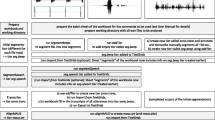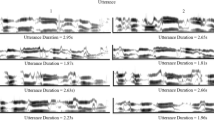Abstract
Phoneme labeling and discrimination experiments were conducted with a continuum of voiced stops produced by a Terminal Analog Speech Synthesizer. The stops ranged from |b| to |d|. Only second formant (F2) transitions changed from one sound to another. (A formant is energy concentrated in a narrow frequency range.) In the labeling experiment conducted to locate the phoneme boundary, subjects identified the individual stimuli as |b| and |d|. In discrimination, difference and identity pairs were presented, with alternative responses of “same” and “different.” This allows separate consideration of discrimination (“different”/Different) and recognition (“same”/Identity) hits, and also analysis of the data in accordance with the theory of signal detectibility. The sounds were discriminated with and without F 1 and F 3 which contained no discriminatory information, but are responsible for perceived similarity to speech. With F 1 F 3 , sensitivity (d′) was highest at the |b-d| boundary, but without F 1 F 3 this was not true. Spectral analysis of the sounds both with and without F 1 F 3 revealed a phonemic energy discontinuity for the 1/3 octave around the F 2 steady-state frequency (1250 Hz). It therefore seems probable that subjects listened to frequencies which contained phonemic information when F 1 F 3 were included, but not when they were omitted. In spite of the high sensitivity at the |b-d| boundary, recognition hits (“same” /Identity) were lowest the boundary had to sound less like a difference to be called “different” than a pair away from the boundary.
Indications, then, are quite strong that auditory-frequency selection helps the perception of speech, and it is clear that a strategy of criterion lowering helps it.
Similar content being viewed by others
References
Ahumada, A. (1967). Detection of tones masked by noise: a comparison of human observers with digital-computer-simulated energy detectors of varying bandwidths. Tech. Rep. No. 29, Human Communication Laboratory, University of California, Los Angeles.
Broadbent, D. E. (1958).Perception and Communication. Pergamon Press, London.
Flanagan, J. L. (1955). A difference limen for vowel formant frequency.J. Acoust. Soc. Am. 27:613–617.
Halle, M. (1959).The Sound Pattern of Russian, Mouton, The Hague, Netherlands.
Hunter, J. L. (1957).Acoustics. Prentice-Hall, Englewood Cliffs, N.J.
Liberman, A. M., Harris, Katherine S., Eimas, P., Lisker, L., and Bastian, J. (1961). An effect of learning on speech perception: the discrimination of durations of silence with and without phonemic significance.Language and Speech 4:175–195.
Liberman, A. M., Harris, Katherine S., Hoffman, H. S., and Griffith, B. C. (1957). The discrimination of speech sounds within and across phoneme boundaries.J. Exptl. Psychol. 54:368–386.
McKinney, N., Tatham, M., and Ladefoged, P. (1966). Terminal analog speech synthesizer.Working papers in Phonetics, University of California at Los Angeles pp. 10–18.
Swets, J. A. (1964).Signal Detection and Recognition by Human Observers. Wiley, New York.
Swets, J. A., and Sewall, S. T. (1961). Stimulus versus response uncertainty in recognition.J. Acoust. Soc. Am. 33:1586–1961.
Winer, B. J. (1962).Statistical Principles in Experimental Design. McGraw-Hill, New York.
Author information
Authors and Affiliations
Rights and permissions
About this article
Cite this article
Popper, R.D. Pair discrimination for a continuum of synthetic voiced stops with and without first and third formants. J Psycholinguist Res 1, 205–219 (1972). https://doi.org/10.1007/BF01074437
Received:
Issue Date:
DOI: https://doi.org/10.1007/BF01074437




